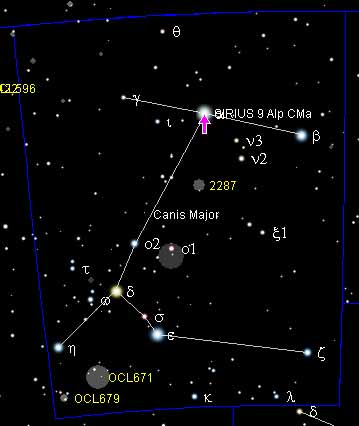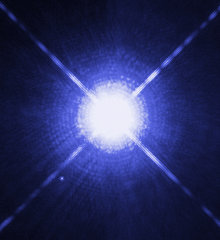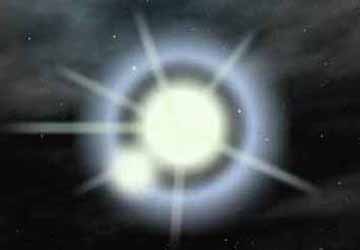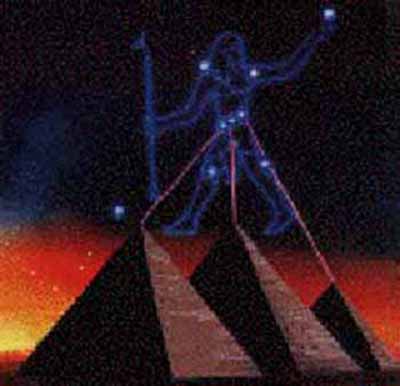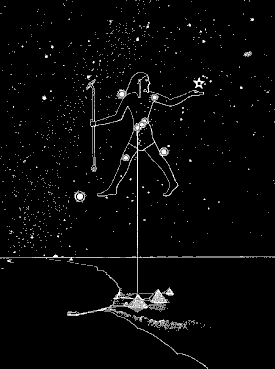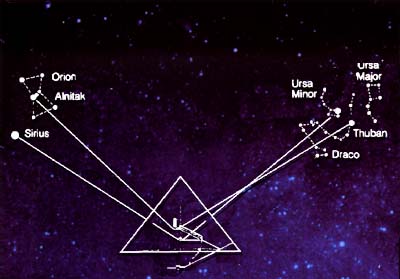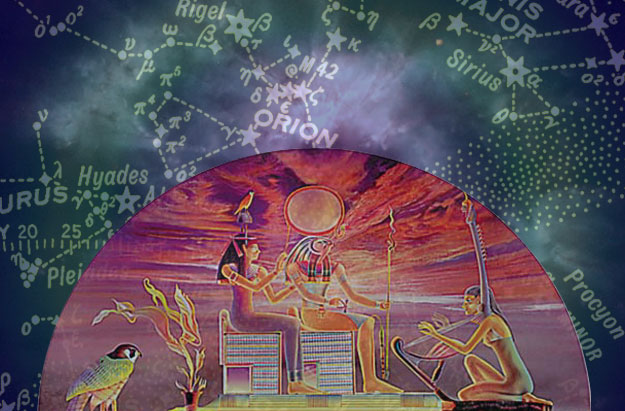o siriusSirius
Sirius is the brightest star in the night-time sky with a visual apparent magnitude of -1.47. It is located in the constellation Canis Major. Sirius can be seen from almost every inhabited region of the Earth's surface (those living north of 73.284 degrees cannot see it) and, in the Northern Hemisphere, is known as a vertex of the Winter Triangle. The best time of year to view it is around January 1, when it reaches the meridian at midnight. Under the right conditions, Sirius can be observed in daylight with the naked eye. Ideally the sky must be very clear, with the observer at a high altitude, the star passing overhead, and the sun low down on the horizon. The name Sirius comes from the Latin sirius. It is situated in the eye of the greater dog Canis Major, therefore it is known as the 'Dog Star'. Other meanings:
What to the eye appears as a single star is actually a large binary star system, consisting of a bright white main sequence star of spectral type A1V, named Sirius A, and a faint white dwarf companion of spectral type DA named Sirius B.
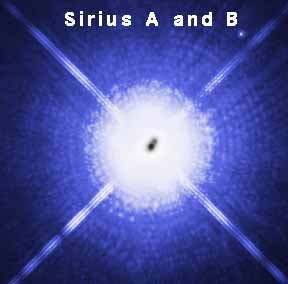 Sirius B is invisible to the naked eye but packs almost the entire mass of our sun into a globe only 4 times as large as the Earth. Sirius B's surface is 300 times harder than diamonds, while its interior has a density 3,000 times that of diamonds. Spinning on its axis about 23 times a minute, it generates huge magnetic fields around it.
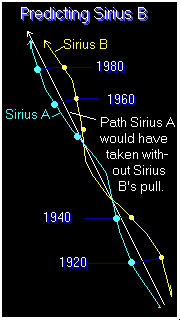 The two stars, Sirius A and Sirius B move around each other, constantly exchanging particles. Because of its greater density and magnetic field, Sirius B takes the lion's share, taking gases and materials off of its larger host body. Sirius B has a super-heavy gravitationally powerful star made of concentrated super-dense matter (essence) with the number 50 associated with it (describing its orbital period). Every 49.9 years, Sirius A and B, come as close together as their orbits allow, creating huge magnetic storms between them. As they approach each other, the stars both begin to spin faster as tidal forces become stronger, finally flip-flopping over, actually trading places with each other. This energy is eventually released to flow on magnetic field lines to the Sun, which transmits it like a lens to all the planets.
Based on changes in its proper motion, in 1844 Friedrich Wilhelm Bessel deduced that Sirius had a hidden companion. In 1862 Alvan Graham Clark discovered the companion, which is called Sirius B, or affectionately "the Pup". The visible star is now sometimes known as Sirius A. The two stars orbit each other with a separation of about 20 AU and a period of close to 50 years. In 1909 Ejnar Hertzsprung suggested that Sirius was a member of the Ursa Major Moving Group, based on the systems movements across the sky. However, more recent research by Jeremy King et al. at Clemson University in 2003 questions whether that is true, since the two components of Sirius appear to be too young. Sirius is roughly half the age of the other members of the stream, so their common motion is most likely a coincidence. In 1915 astronomers at the Mount Wilson Observatory determined that Sirius B was a white dwarf star , the first to be discovered. This means that Sirius B must have originally been by far the more massive of the two, since it has already evolved off the main sequence.
In 1920 the first spectrum of Sirius B was obtained at Mount Wilson Obvservatory. Sirius B although small and faint and about 10,000 times dimmer than Sirius A is extremely dense and heavy enough to exert influence on Sirius A. The pull of its gravity caused Sirius' wavy movement The diameter of Sirius A was first measured by Robert Hanbury Brown and Richard Q. Twiss in 1959 at Jodrell Bank using their stellar intensity interferometer. In 1970 the first photograph was taken of Sirius B by Dr. Irving W. Lendenblad of the US Naval Observatory. In 2005, using the Hubble Space Telescope, astronomers determined that Sirius B has nearly the diameter of the Earth, 12,000 kilometers (7,500 miles), with a mass that is 98% of the Sun. The Voyager 2 spacecraft, launched in 1977 to study the four Jovian planets in the Solar System, is expected to pass within 4.3 light years of Sirius in approximately 296,000 years time. Could there be a Sirius C? In 1995 two French researchers, Daniel Benest and J.L. Duvent, authored an article in the prestigious journal Astronomy and Astrophysics with the title Is Sirius a Triple Star? and suggested (based on observations of motions in the Sirius system) there is a small third star there. They thought the star was probably of a type known as a brown dwarf and only had about .05 the mass of Sirius B.
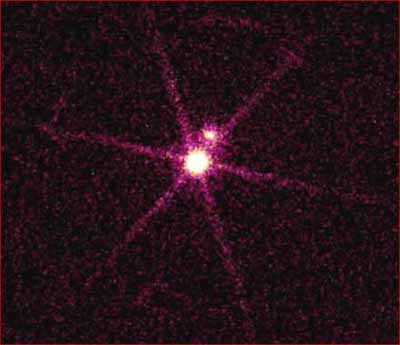 X-Rays From Sirius B - NASA
Curiously, some ancient observations of Sirius describe it as a red star. To the Romans this meant an angry god, and they are known to have sacrificed red dogs to this star. Today, Sirius A is bluish white. The possibility that stellar evolution of either Sirius A or Sirius B could be responsible for this discrepancy is rejected by astronomers on the grounds that the timescale of thousands of years is too short and that there is no sign of the nebulosity in the system that would be expected had such a change taken place. Alternative explanations are either that the description as red is a poetic metaphor for ill fortune, or that the dramatic scintillations of the star when it was observed rising left the viewer with the impression that it was red. To the naked eye, it often appears to be flashing with red/white/blue hues when near the horizon. Sirius is the standard star for the color white in ancient China. Multiple records from the 2nd century BC up to the 7th century AD all describe Sirius as white in hue.
Historically, many cultures have attached special significance to Sirius.
In the Sumerian Civilization, predating the Egyptians, their epic poem Epic of Gilgamesh describes a dream of Gilgamesh where the hero is drawn irresistibly to a heavy star that cannot be lifted despite immense effort. This star descends from heaven to him and is described as having a very 'potent essence' and being "the God of heaven". Gilgamesh had for his companions, 50 oarsmen in the great ship, Argo, a constellation bordering Canis Major, where Sirius is found.
Sirius was astronomically the foundation of the Egyptian religious system. It was the embodiment of Isis, wife and consort of the god Osiris, who appeared in the sky as Orion. Ancient Egyptians called Sirius the 'Dog Star', after their god Osiris, whose head in pictograms resembled that of a dog. In Egypt, Sirius shines for most of the summer, and since it is such a bright star, the Egyptians actually believed that the additional light from this nearby star was responsible for the summer heat. This of course is not true. However the origin of the phrase 'the dog days of summer' comes from this ancient belief, the 'dog star' being the root of this common saying. Sirius was worshipped as Sothis in the valley of the Nile. Sothis is the Greek name of a star that the Egyptians considered most significant. Sophis is concluded by modern scholars to Sirius. The Goddess Sothis, Sopdet, Sepdet personified the 'dog star' Sirius. This star was the most important of the stars to the ancient Egyptians, and the heliacal rising of this star came at the time of flooding and the start of the Egyptian New Year.
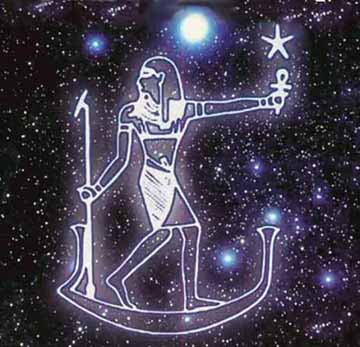 The Middle Kingdom based their calendar on the heliacal rising of Sirius, which occurred just before the annual flooding of the Nile and the summer solstice.
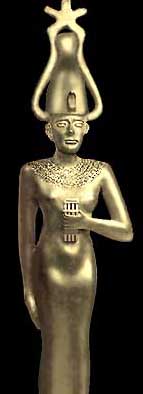 Sothis, and her husband, the god Sah, came to be viewed as manifestations of Isis and Osiris. She was represented as a woman with a star on top of her headdress, or as a seated cow with a plant between her horns (just as Seshat's hieroglyph might have been a flower or a star) as depicted on an ivory tablet of King Djer. The plant may have been symbolic of the year, and thus linking her to the yearly rising of Sirius and the New Year. She was very occasionally depicted as a large dog, or in Roman times, as the goddess Isis-Sopdet, she was shown riding side-saddle on a large dog. Sirius was both the most important star of ancient Egyptian astronomy, and one of the Decans (star groups into which the night sky was divided, with each group appearing for ten days annually). The heliacal rising (the first night that Sirius is seen, just before dawn) was noticed every year during July, and the Egyptians used this to mark the start of the New Year ('The Opening of the Year'). It was celebrated with a festival known as 'The Coming of Sopdet'.
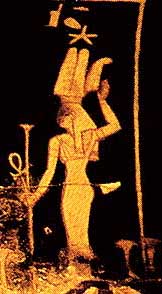 As early as the 1st Dynasty, Sophis was known as 'the bringer of the new year and the Nile flood'. When Sirius appeared in the sky each year, the Nile generally started to flood and bring fertility to the land. The ancient Egyptians connected the two events, and so Sopdet took on the aspects of a goddess of not only the star and of the inundation, but of the fertility that came to the land of Egypt with the flood. The flood and the rising of Sirius also marked the ancient Egyptian New Year, and so she also was thought of as a goddess of the New Year. Her aspect of being a fertility goddess was not just linked to the Nile. By the Middle Kingdom, she was believed to be a mother goddess, and a nurse goddess, changing her from a goddess of agriculture to a goddess of motherhood. This probably was due to her strong connection with the mother-goddess Isis. Not just a goddess of the waters of the inundation, Sopdet had another link with water - she was believed to cleanse the pharaoh in the afterlife. It is interesting to note that the embalming of the dead took seventy days - the same amount of time that Sirius was not seen in the sky, before it's yearly rising. She was a goddess of fertility to both the living and the dead. In the Pyramid Texts, she is the goddess who prepares yearly sustenance for the pharaoh, 'in this her name of "Year"'. She is also thought to be a guide in the afterlife for the pharaoh, letting him fly into the sky to join the gods, showing him 'goodly roads' in the Field of Reeds and helping him become one of the imperishable stars. She was thought to be living on the horizon, encircled by the Duat. In Egyptian mythology, Duat (or Tuat) (also called Akert, Amenthes or Neter-khertet) is the underworld, where the sun god Ra traveled from west to east during the night, and where he battled Apep. It was also the place where people's souls went after death. The structure of the Duat, and the dangers faced there by dead souls, are detailed in texts such as the Book of Gates and the Book of the Dead. The most famous scene from the Duat is the Weighing of the Heart, in which the dead were judged by Anubis, using a feather, representing Ma'at, the goddess of Truth. Souls which were weighted down by sin were eaten by Ammit. It is not known, however, whether a sinner's heart is heavier or lighter than the feather, only that to be accepted into Aaru the heart must weigh the same. In the Pyramid Texts, paralleling the story of Osiris and Isis, the pharaoh was believed to have had a child with Sopdet: "Your sister Isis comes to you rejoicing for love of you. You have placed her on your phallus and your seed issues into her, she being ready as Sopdet, and Horus-Soped has come forth from you as Horus who is in Sopdet." Sopdet was believed to be wife of Sah (the star Orion) and the mother of Soped (Sopdu). She was also thought to give birth to the Morning Star (Venus), the pharaoh being described as the father in the Pyramid Texts. She was linked closely with Isis, just as Sah and Soped were linked with Osiris and Horus. In 'The Lamentations of Isis and Nephthys for Osiris', Isis calls herself Sopdet, saying that she will follow Osiris in the heaven. Sopdet was also connected to the goddess Satet at Abu (Elephantine). She was also given a masculine aspect, and linked with Horus as Sopdet-Horus during the Middle Kingdom. She was also linked with Anubis during Greek Times as Sopdet-Anubis, probably because of the iconography of her as a god, or riding on the back of a dog. She was also linked with other goddesses such as Hathor -- Bast and Anqet, the Embracer, Goddess of Fertility and the Nile at Aswan.
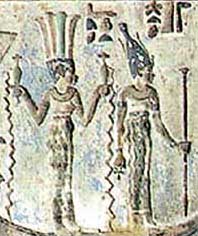 She was worshiped through Egyptian history, from predynastic times, through to the Graeco-Roman period. She was venerated in Per-Soped (Saft al Hinna), in the 20th Nome of Lower Egypt.
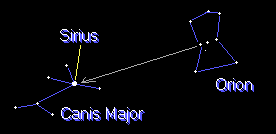
Belt Stars of Orion and the Great Pyramid
Sirius, The God, Dog Star
Sirius was an object of wonder and veneration to all ancient peoples throughout human history. In the ancient Vedas this star was known as the Chieftain's star; in other Hindu writings, it is referred to as Sukra, the Rain God, or Rain Star. The Dog is also described as "he who awakens the gods of the air, and summons them to their office of bringing the rain." Sirius was revered as the Nile Star, or Star of Isis, by the ancient Egyptians. Its annual appearance just before dawn at the summer solstice, June 21, heralded the coming rise of the Nile, upon which Egyptian agriculture depended. This helical rising is referred to in many temple inscriptions, where the star is known as the Divine Sepat, identified as the soul of Isis. In the temple of Isis-Hathor at Dedendrah, Egypt, appears the inscription, "Her majesty Isis shines into the temple on New Year's Day, and she mingles her light with that of her father on the horizon." The Arabic word Al Shi'ra resembles the Greek, Roman, and Egyptian names suggesting a common origin in Sanskrit, in which the name Surya, the Sun God, simply means the "shining one." For up to 35 days before, and 35 days after the sun conjuncts it close to July 4, the star Sirius is hidden by the sun’s glare. The ancient Egyptians refused to bury their dead during the 70 days Sirius was hidden from view, because it was believed Sirius was the doorway to the afterlife, and the doorway was thought to be closed during this yearly period.
The dog Sirius is one of the watchmen of the Heavens, fixed in one place at the bridge of the Milky Way, keeping guard over the abyss into incarnation. The Dog Star is a symbol of power, will, and steadfastness of purpose, and exemplifies the One who has succeeded in bridging the lower and higher consciousness. Located just below the Dog Star is the constellation called Argo, the Ship. Astrologically its area in the sky has been known as the river of stars, which is a gateway to the ocean of higher consciousness. The Chinese recognized this place as the bridge between heaven and hell, the bridge of the gatherer, the judge. In the higher mind are gathered the results of the experiences of the personality. Between each life the soul judges its past progress, and the conditions needed to aid its future growth. As long as it is attached to desire, sensation, and needs experiences, it takes a body. The soul cannot pass over the "bridge" until it is perfected. The association of Sirius as a celestial dog has been consistent throughout the classical world; even in remote China, the star was identified as a heavenly wolf. In ancient Chaldea (present day Iraq) the star was known as the "Dog Star that Leads," or it was called the "Star of the Dog." In Assyria, it was said to be the "Dog of the Sun." In still older Akkadia, it was named the "Dog Star of the Sun." In Greek times Aratus referred to Canis Major as the guard dog of Orion, following on the heels of its master, and standing on its hind legs with Sirius carried in its jaws. Manilius called it the "dog with the blazing face." Canis Major (Large Dog) seems to cross the sky in pursuit of the Hare, represented by the constellation Lepus under Orion's feet. The concept of the mind slaying the real can be seen in the tales which relate the dog as the hunter and killer ~ the hound from hell. Mythologists such as Eratosthenes said that the constellation represents Laelaps, a dog so swift that no prey could escape it. Laelaps had a long list of owners. One story says it is the dog given by Zeus to Europa, whose son Minos, King of Crete passed it on to Procris, daughter of Cephalus. The dog was presented to Procris along with a javelin that could never miss. Ironically, Cephalus accidentally killed her while out hunting with Laelaps. Cephalus inherited the dog and took it with him to Thebes, north of Athens, where a vicious fox was ravaging the countryside. The fox was so swift that it was destined never to be caught ~ yet Laelaps the hound was destined to catch whatever it pursued. Off they went, almost faster than the eye could follow, the inescapable dog in pursuit of the uncatchable fox. At one moment the dog would seem to have its prey within grasp, but could only close its jaws on thin air as the fox raced ahead of it again. There could be no resolution of such a paradox, so Zeus turned them both to stone and placed the dog in the sky without the fox. There is a remarkable analogy in the Chinese double meaning of the word Spirit and the word Sing (star). Shin and Sting, the words for soul and essence in Chinese, are often interchangeable, as they are in the English language. It is said that the fixed stars, and their domain, contain the essences or souls of matter ... a living soul is a higher essence of matter, and when evolved may also be called a star. These stars and essences become gods. Like souls, stars are regarded as having divine attributes. Stars look down from regions of chaotic, violent, purity onto the world of humanity and influence the energies of humankind invisibly, yet most powerfully.
For esoteric sharing on Sirius ... see Our Spiritual Sun~Sirius For more synthesis on Sirius ... see SouledOut.org's Highlights~Sirius http://www.souledout.org/cosmology/sirius/siriusgodstar.html |
